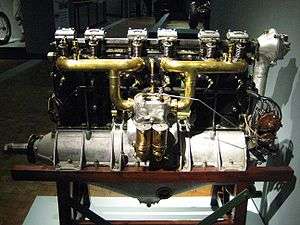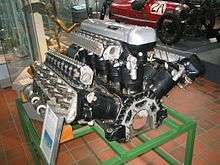Inline engine (aeronautics)
In aviation, an inline engine is a reciprocating engine with banks of cylinders, one behind another, rather than rows of cylinders, with each bank having any number of cylinders, although more than six is uncommon.

The term "inline" is used somewhat differently for aircraft engines than automotive engines. For automotive engines, the term ‘inline’ refers only to straight engines (those with a single bank of cylinders). But for aircraft, ‘inline’ can also refer to engines which are not of the straight configuration, such as v, w, or horizontally opposed.
Inline engine configurations
- Straight or Inline
- Engines with a single bank of cylinders which can be arranged at any angle but typically upright or inverted, (e.g. upright ADC Cirrus, inverted de Havilland Gipsy Major).
- V
- Engines with two banks of cylinders with less than 180° between them driving a common crankshaft, typically arranged upright or inverted (e.g. upright Liberty L-12, inverted Argus As 410).[1][2]

- O or Horizontally Opposed
- Engines with two banks of cylinders arranged at 180° to each other driving a common crankshaft, almost universally mounted with banks horizontal for aircraft use, or with crankshaft vertical for helicopter use, (e.g. horizontally mounted Continental O-190, vertically mounted Franklin 6ACV-245).
- W
- Engines with three banks driving a common crankshaft, arranged so that first and last banks are 180°or less apart, (e.g. upright Lorraine 12Eb, inverted Napier Lioness).[3][4]
- X
- Multiple bank engines with four banks arranged around a common crankshaft, usually spaced evenly, (e.g. evenly spaced Rolls-Royce Vulture, unevenly spaced Napier Cub).
- Fan
- Engines with more than three banks with 180° or less between first and last bank, akin to W engines.
Note: Fan engines with single cylinder banks, typically from Anzani, are usually regarded as variants of the Radial engine.

- U
- Engines with two banks of cylinders side by side driving separate crankshafts geared to a single output, (e.g. Bugatti U-16).
- H
- Engines with four banks of cylinders driving two crankshafts geared to a single output, in effect, two Opposed engines coupled together and mounted either horizontally or vertically, (e.g. horizontally Napier Sabre, vertically Napier Dagger).
- Opposed piston
- Two-stroke engines, typically compression ignition/Diesel, with a single bank of cylinders driving two crankshafts where the pistons travel towards each other forming single combustion chambers, (e.g. Jumo 207).
- Deltic: Engines with three banks of opposed piston cylinders arranged in a triangle with three crankshafts geared to drive a single output,(e.g. Napier Deltic)
- Rhomboidal: Engines with four or more banks of opposed piston cylinders arranged in a square with four crankshafts geared to drive a single output,(e.g. Jumo 223)
Note: There is no theoretical limit to the number banks in an opposed piston engine, limitations include cost, complexity and reliability.
- Multiple bank
- Engines with more than two banks, arranged around a common axis and/or crankshaft with more than 180° between first and last banks.
- Star: Multiple bank engines with an even number of banks (more than four) arranged around a common axis and/or driving a common crankshaft with more than 180° between first and last banks, (e.g. Jumo 222, Dobrynin VD-4K).
- Inline Radial: Multiple bank engines, usually liquid-cooled, with an odd number of banks (three or more) arranged around a common axis and/or driving a common crankshaft with more than 180° between first and last banks, (e.g. air-cooled Armstrong Siddeley Deerhound, liquid-cooled BMW 803).
Note The BMW 803 is not only an inline radial engine but is also a coupled engine with two engines arranged back to back on a common axis driving separate co-axial propellers through a common gearbox.
Inverted engine
Some inline aircraft engines, including the de Havilland Gipsy Major used in the de Havilland Tiger Moth, and the Daimler-Benz DB 601 used in the Messerschmitt Bf 109, were designed to be installed in airframes inverted, such that the crankshaft was at the top of the engine and the cylinder heads were at the bottom. The advantages of inverted engines included improved visibility for the pilot, improved access to cylinder heads and manifolds for the ground crew,[5][6][7] having the centre of mass of a multi-bank engine lower in the engine, and having the widest part of a multi-bank engine being closer to the midline of the fuselage, which is also generally wide.[5]
References
Citations
- Johnson, E.R., United States Naval Aviation, 1919-1941: Aircraft, Airships and Ships Between the Wars, p.326: "INLINE ENGINE–A type of reciprocating piston engine in which an even (4-6-8-12) number of cylinders are arranged either in a straight line or in a V-type configuration directly above (or below) the crankcase. Most early inline aircraft engines were water-cooled via a radiator system, though air-cooled types began to appear during the 1930s."
- Bowman, M., Hector, G, P-47 Thunderbolt Vs. Bf 109G/K: Europe 1943-45, p.8
- "Napier Lion". The Racing Campbells. Archived from the original on 2009-09-14. Retrieved 2012-06-30.
The Lion was a 12-cylinder W-block inline aircraft engine built by Napier & Son starting in 1917, and ending in the 1930s.
External link in|work=(help) - Johnson, E.R., United States Naval Aviation, 1919-1941: Aircraft, Airships and Ships Between the Wars, p.303: "General specifications: type, single-seat torpedo plane; one 450-hp Napier Lion 1B inline engine; length..."
- Wilkinson, Stephan (2005). "DB-601". Man And Machine: The Best of Stephan Wilkinson. Globe Pequot. p. 174. ISBN 1-59228-812-X. Retrieved 2013-01-24.
The widest part of the engine–the two banks of cylinder heads–were down near the already wide midline of the fuselage.
- Meyers, W. G. (September 1925). Mitchell, Harley W. (ed.). "Future Possibilities in Aircraft Engine Design". Aeronautics. Chicago, IL USA: Aeronautical Publications. 5 (3): 85. Retrieved 2013-01-24.
(4) Its high center of thrust insures better flying qualities by offsetting a tendency of the ship to climb when full power is suddenly thrown on,
- SAE Transactions, Volume 20, Part 1. Society of Automotive Engineers. 1926.
The Inverted Type Has Four Major Advantages: (a) Improved Visibility, (b) High Center of Thrust, (c) Accessibility for Maintenance, and (d) Gravity Fuel-Feed found to be particularly desirable for load-carrying airplanes...
Bibliography
- Bowman, Martin; Hector, Gareth (Aug 19, 2008). "Design and Development". P-47 Thunderbolt Vs. Bf 109G/K: Europe 1943-45. Duel Series. 11. Illustrated by: Jim Laurier, Chris Davey. Osprey Publishing. p. 8. ISBN 978-1-84603-315-5.
Kartveli, meanwhile, had a new fighter project on the drawing board called the AP-10, which was a relatively lightweight machine designed around a 1,150 hp Allison V-1710-39 liquid-cooled V12 inline engine and armed with two 0.50-in. machine guns in the nose.
- Johnson, E. R. (Apr 20, 2011). United States Naval Aviation, 1919-1941: Aircraft, Airships and Ships Between the Wars (illustrated ed.). McFarland. ISBN 978-0-78644-550-9.